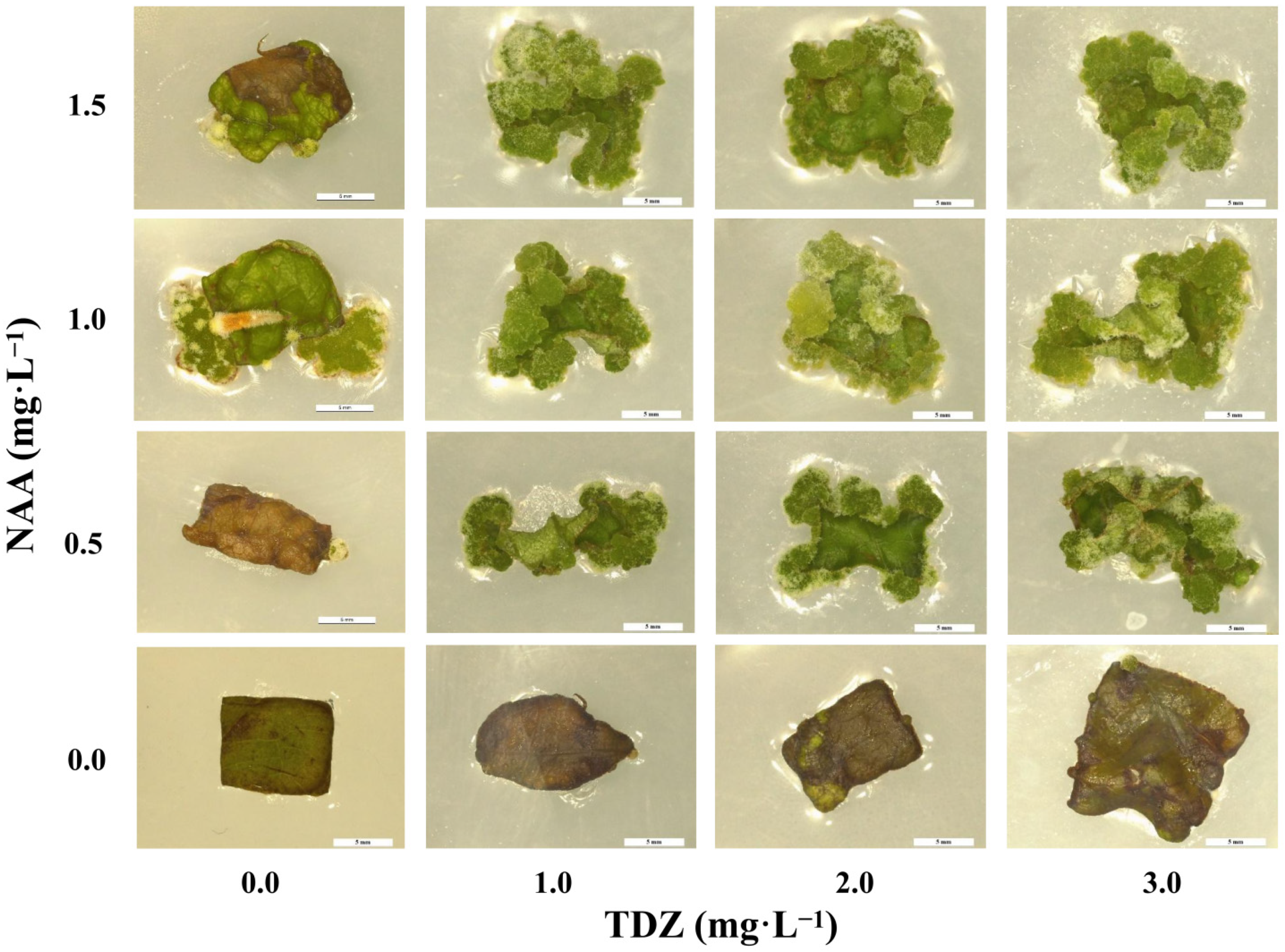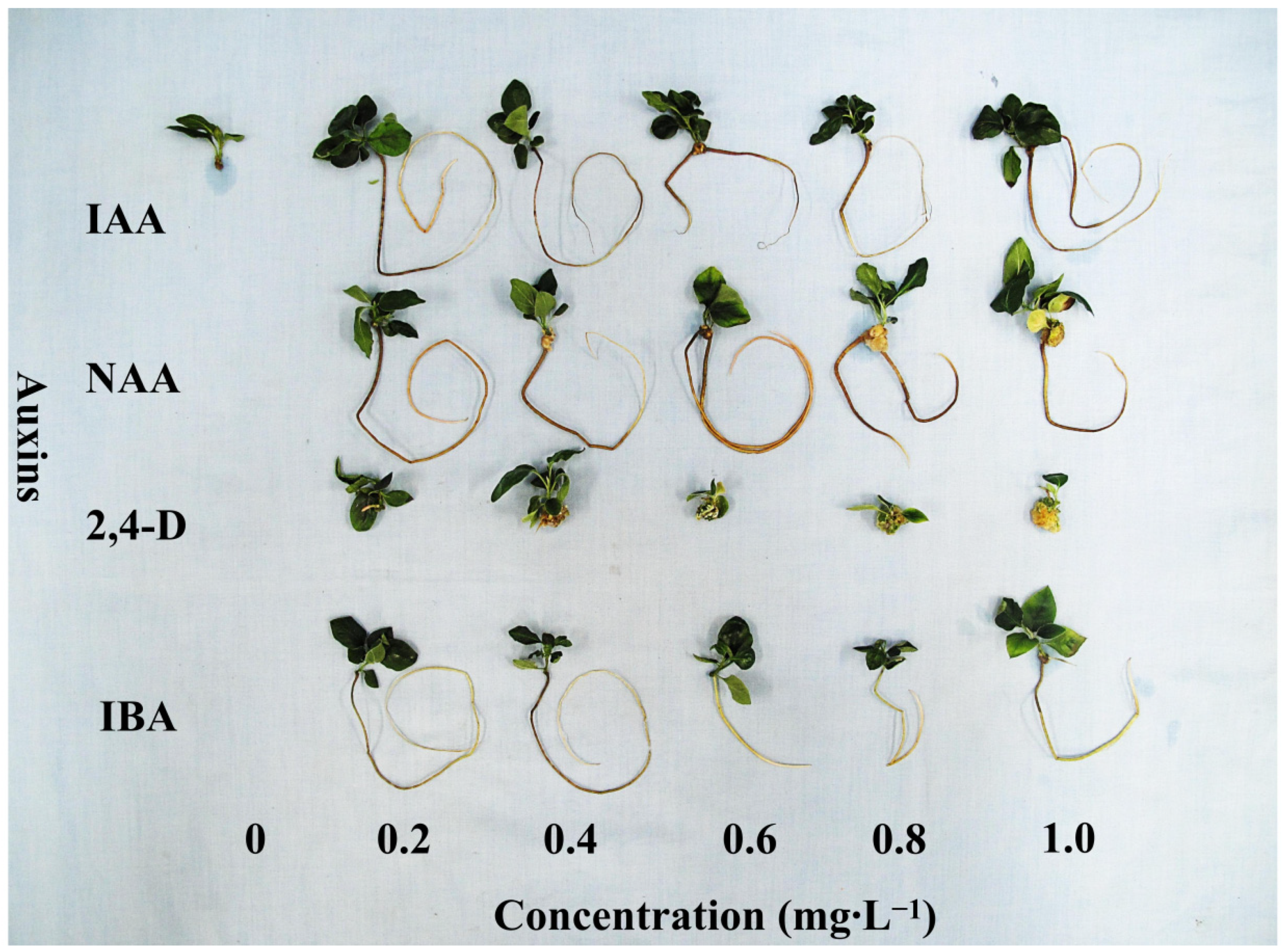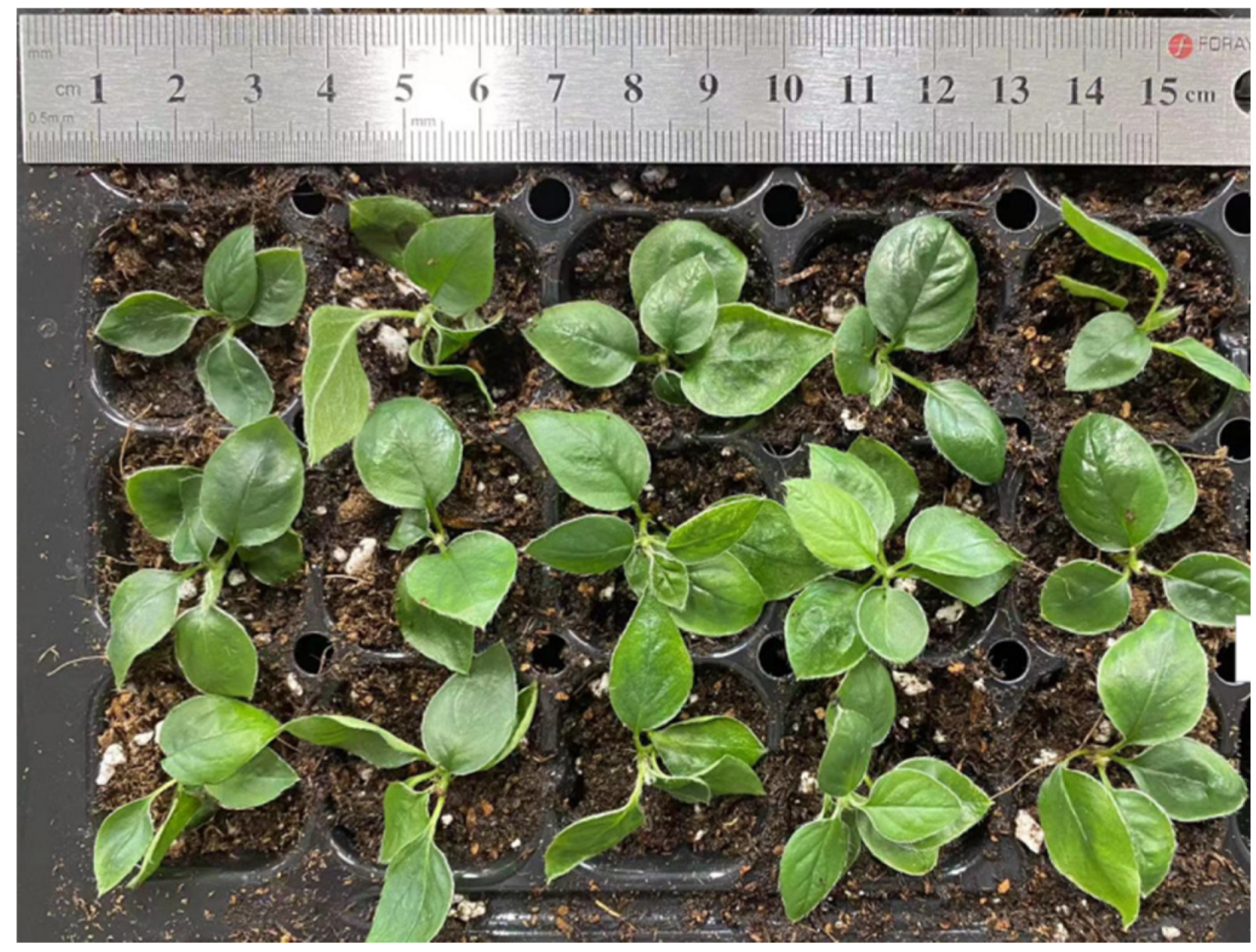Regeneration of Cotoneaster wilsonii Nakai through Indirect Organogenesis
Abstract
:1. Introduction
2. Materials and Methods
2.1. Explant Preparation
2.2. Callus Induction
2.3. Shoot Induction
2.4. Root Induction
2.5. Acclimatization
2.6. Statistical Analysis
3. Results
3.1. Callus Induction
| TDZ (A, mg·L−1) | NAA (B, mg·L−1) | Callus | |
|---|---|---|---|
| Induction Ratio (%) | Weight (mg) | ||
| 0.0 | 0.0 | 0 e 1 | 16.9 g |
| 0.5 | 76 b | 35.9 fg | |
| 1.0 | 96 ab | 128.4 f | |
| 1.5 | 48 c | 57.2 fg | |
| 1.0 | 0.0 | 15 d | 35.9 fg |
| 0.5 | 100 a | 213.9 e | |
| 1.0 | 100 a | 282.2 de | |
| 1.5 | 100 a | 471.6 a | |
| 2.0 | 0.0 | 15 d | 36.5 fg |
| 0.5 | 100 a | 274.5 de | |
| 1.0 | 100 a | 332.1 cd | |
| 1.5 | 100 a | 400.1 abc | |
| 3.0 | 0.0 | 15 d | 42.4 fg |
| 0.5 | 100 a | 373.3 bc | |
| 1.0 | 100 a | 456.2 ab | |
| 1.5 | 100 a | 483.4 a | |
| F-test 2 | A | *** | *** |
| B | *** | *** | |
| A × B | *** | *** | |
3.2. Shoot Induction
3.3. Root Induction
3.4. Acclimatization
4. Discussion
5. Conclusions
Author Contributions
Funding
Institutional Review Board Statement
Informed Consent Statement
Data Availability Statement
Conflicts of Interest
References
- Dickoré, W.B.; Kasperek, G. Species of Cotoneaster (Rosaceae, Maloideae) indigenous to, naturalising or commonly cultivated in Central Europe. Willdenowia 2010, 40, 13–45. [Google Scholar]
- Chang, C.S.; Jeon, J.I. Leaf flavonoids in Cotoneaster wilsonii (Rosaceae) from the island Ulleung-do, Korea. Biochem. Syst. Ecol. 2003, 31, 171–179. [Google Scholar]
- Yoo, N.H.; Kim, H.K.; Lee, C.O.; Park, J.H.; Kim, M.J. Comparison of anti-oxidant and anti-inflammatory activities of methanolic extracts obtained from different parts of Cotoneaster wilsonii Nakai. Korean J. Med. Crop Sci. 2019, 27, 194–201. [Google Scholar]
- Yang, J.; Kim, S.H.; Pak, J.H.; Kim, S.C. Infrageneric Plastid Genomes of Cotoneaster (Rosaceae): Implications for the Plastome Evolution and Origin of C. wilsonii on Ulleung Island. Genes 2022, 13, 728. [Google Scholar]
- Yang, J.Y.; Pak, J.H.; Kim, S.C. Chloroplast genome of critically endangered Cotoneaster wilsonii (Rosaceae) endemic to Ulleung Island, Korea. Mitochondrial DNA B 2019, 4, 3892–3893. [Google Scholar]
- Sivanesan, I.; Song, J.Y.; Hwang, S.J.; Jeong, B.R. Micropropagation of Cotoneaster wilsonii Nakai—A rare endemic ornamental plant. Plant Cell Tissue Organ Cult. 2011, 105, 55–63. [Google Scholar]
- Marković, M.; Grbić, M.; Skočajić, D.; Đukić, M.; Đunisijević-Bojović, D. Propagation of Cotoneaster multiflorus Bunge. By softwood cuttings. In Proceedings of the IX International Scientific Agriculture Symposium, Jahorina, Bosnia and Herzegovina, 4–7 October 2018; pp. 339–342. [Google Scholar]
- Mallón, R.; Rodríguez-Oubiña, J.; González, M.L. Shoot regeneration from in vitro-derived leaf and root explants of Centaurea ultreiae. Plant Cell Tissue Organ Cult. 2011, 106, 523–530. [Google Scholar]
- Ahmad, N.; Faisal, M.; Anis, M.; Aref, I.M. In vitro callus induction and plant regeneration from leaf explants of Ruta graveolens L. S. Afr. J. Bot. 2010, 76, 597–600. [Google Scholar]
- Gantait, S.; Mahanta, M. Picloram-induced enhanced callus-mediated regeneration, acclimatization, and genetic clonality assessment of gerbera. J. Genet. Eng. Biotechn. 2021, 19, 175. [Google Scholar]
- Kumar, G. Forest biotechnology: Developments and prospects. Plant Cell Biotechnol. Mol. Biol. 2000, 1, 13–28. [Google Scholar]
- Sakakibara, H.; Takei, K.; Hirose, N. Interactions between nitrogen and cytokinin in the regulation of metabolism and development. Trends Plant Sci. 2006, 11, 440–448. [Google Scholar]
- Khanam, N.; Khoo, C.; Khan, A. Effects of cytokinin/auxin combinations on organogenesis, shoot regeneration and tropane alkaloid production in Duboisia myoporoides. Plant Cell Tissue Organ Cult. 2000, 62, 125–133. [Google Scholar]
- Schaller, G.E.; Street, I.H.; Kieber, J.J. Cytokinin and the cell cycle. Curr. Opin. Plant Biol. 2014, 21, 7–15. [Google Scholar]
- Abdouli, D.; Plackova, L.; Doležal, K.; Bettaieb, T.; Werbrouck, S.P. Topolin cytokinins enhanced shoot proliferation, reduced hyperhydricity and altered cytokinin metabolism in Pistacia vera L. seedling explants. Plant Sci. 2022, 322, 111360. [Google Scholar]
- Bairu, M.W.; Stirk, W.A.; Dolezal, K.; Van Staden, J. Optimizing the micropropagation protocol for the endangered Aloe polyphylla: Can meta-topolin and its derivatives serve as replacement for benzyladenine and zeatin? Plant Cell Tissue Organ Cult. 2007, 90, 15–23. [Google Scholar]
- Murthy, B.; Murch, S.; Saxena, P.K. Thidiazuron: A potent regulator of in vitro plant morphogenesis. Vitr. Cell. Dev. Biol.-Plant 1998, 34, 267–275. [Google Scholar]
- Ngomuo, M.; Mneney, E.; Ndakidemi, P. The effects of auxins and cytokinin on growth and development of Musa sp. var. ‘Yangambi’ explants in tissue culture. Am. J. Plant Sci. 2013, 4, 2174. [Google Scholar]
- Yu, J.; Liu, W.; Liu, J.; Qin, P.; Xu, L. Auxin control of root organogenesis from callus in tissue culture. Front. Plant Sci. 2017, 8, 1385. [Google Scholar]
- Lima, E.C.; Paiva, R.; Nogueira, R.C.; Soares, F.P.; Emrich, E.B.; Silva, Á.A.N. Callus induction in leaf segments of Croton urucurana Baill. Ciênc. Agrotec. 2008, 32, 17–22. [Google Scholar]
- Yan, M.M.; Xu, C.; Kim, C.H.; Um, Y.C.; Bah, A.A.; Guo, D.P. Effects of explant type, culture media and growth regulators on callus induction and plant regeneration of Chinese jiaotou (Allium chinense). Sci. Hortic. 2009, 123, 124–128. [Google Scholar]
- Wybouw, B.; De Rybel, B. Cytokinin–a developing story. Trends Plant sci. 2019, 24, 177–185. [Google Scholar]
- Gopitha, K.; Bhavani, A.L.; Senthilmanickam, J. Effect of the different auxins and cytokinins in callus induction, shoot, root regeneration in sugarcane. Int. J. Pharma Bio Sci. 2010, 1, 1–7. [Google Scholar]
- Irvani, N.; Solouki, M.; Omidi, M.; Zare, A.R.; Shahnazi, S. Callus induction and plant regeneration in Dorem ammoniacum D., an endangered medicinal plant. Plant Cell Tissue Organ Cult. 2010, 100, 293–299. [Google Scholar]
- Xu, C.; Cao, H.; Zhang, Q.; Wang, H.; Xin, W.; Xu, E.; Zhang, S.; Yu, R.; Yu, D.; Hu, Y. Control of auxin-induced callus formation by bZIP59–LBD complex in Arabidopsis regeneration. Nat. Plants 2018, 4, 108–115. [Google Scholar]
- Fan, M.; Xu, C.; Xu, K.; Hu, Y. Lateral organ boundaries domain transcription factors direct callus formation in Arabidopsis regeneration. Cell Res. 2012, 22, 1169–1180. [Google Scholar]
- Huetteman, C.A.; Preece, J.E. Thidiazuron: A potent cytokinin for woody plant tissue culture. Plant Cell Tissue Organ Cult. 1993, 33, 105–119. [Google Scholar]
- Jones, M.; Yi, Z.; Murch, S.J.; Saxena, P.K. Thidiazuron-induced regeneration of Echinacea purpurea L.: Micropropagation in solid and liquid culture systems. Plant Cell Rep. 2007, 26, 13–19. [Google Scholar]
- Novikova, T.I.; Zaytseva, Y.G. TDZ-induced morphogenesis pathways in woody plant culture. In Thidiazuron: From Urea Derivative to Plant Growth Regulator; Ahmad, N., Faisal, M., Eds.; Springer: Singapore, 2018; pp. 61–94. [Google Scholar]
- Negishi, N.; Nakahama, K.; Urata, N.; Kojima, M.; Sakakibara, H.; Kawaoka, A. Hormone level analysis on adventitious root formation in Eucalyptus globulus. New Forest. 2014, 45, 577–587. [Google Scholar]
- Waite, D.T.; Cessna, A.J.; Grover, R.; Kerr, L.A.; Snihura, A.D. Environmental concentrations of agricultural herbicides: 2,4-D and triallate. J. Environ. Qual. 2002, 31, 129–144. [Google Scholar]
- Tofanelli, M.B.D.; Freitas, P.L.; Pereira, G.E. 2, 4-dichlorophenoxyacetic acid as an alternative auxin for rooting of vine rootstock cuttings. Rev. Bras. Frutic. 2014, 36, 664–672. [Google Scholar]
- Phillips, G.C.; Garda, M. Plant tissue culture media and practices: An overview. Vitr. Cell. Dev. Biol.-Plant 2019, 55, 242–257. [Google Scholar]
- Ljung, K.; Bhalerao, R.P.; Sandberg, G. Sites and homeostatic control of auxin biosynthesis in Arabidopsis during vegetative growth. Plant J. 2001, 28, 465–474. [Google Scholar]




| TDZ (mg·L−1) | BA (mg·L−1) | NAA (mg·L−1) | Induction (%) | No. of Shoots/Callus | Callus Browning (%) |
|---|---|---|---|---|---|
| 0.0 | 0.0 | 0.0 | 0.0 c 1 | 0.0 e | 77.7 a |
| 0.5 | 0.2 | 11.1 bc | 0.7 de | 0.0 c | |
| 1.0 | 0.2 | 22.2 bc | 2.5 d | 33.3 b | |
| 0.5 | 0.0 | 0.2 | 11.1 bc | 0.3 de | 0.0 c |
| 0.5 | 0.2 | 33.3 ab | 2.7 bc | 0.0 c | |
| 1.0 | 0.2 | 22.2 bc | 3.0 cd | 22.2 bc | |
| 1.0 | 0.0 | 0.2 | 44.4 a | 5.3 a | 11.1 bc |
| 0.5 | 0.2 | 33.3 ab | 3.3 b | 0.0 c | |
| 1.0 | 0.2 | 33.3 ab | 4.8 b | 22.2 bc |
| Auxin | Concentration (mg·L−1) | Rooting (%) | No. of Roots/Plant | Root Length (cm) |
|---|---|---|---|---|
| - | 0.0 | 0 e 1 | 0.0 c | 0.0 f |
| IAA | 0.2 | 10 de | 1.0 bc | 10.2 ef |
| 0.4 | 40 cd | 1.3 abc | 17.1 ab | |
| 0.6 | 50 bcd | 1.4 ab | 11.4 cde | |
| 0.8 | 70 a | 1.1 abc | 15.5 bcd | |
| 1.0 | 30 cde | 1.3 abc | 15.4 bcd | |
| NAA | 0.2 | 60 abc | 1.0 bc | 10.2 def |
| 0.4 | 60 abc | 1.7 ab | 10.3 def | |
| 0.6 | 40 cd | 1.3 abc | 15.9 bcd | |
| 0.8 | 30 cde | 1.7 ab | 7.9 ef | |
| 1.0 | 50 bc | 1.6 ab | 6.9 ef | |
| 2,4-D | 0.2 | 10 de | 1.0 bc | 0.3 ef |
| 0.4 | 10 de | 1.0 bc | 1.3 ef | |
| 0.6 | 0 e | 0.0 c | 0.0 f | |
| 0.8 | 0 e | 0.0 c | 0.0 f | |
| 1.0 | 0 e | 0.0 c | 0.0 f | |
| IBA | 0.2 | 10 de | 1.0 bc | 12.3 cde |
| 0.4 | 50 bcd | 1.2 abc | 19.6 a | |
| 0.6 | 40 cd | 1.3 ab | 11.4 cde | |
| 0.8 | 30 cde | 1.0 bc | 9.8 def | |
| 1.0 | 40 cd | 1.8 a | 13.7 cde |
Publisher’s Note: MDPI stays neutral with regard to jurisdictional claims in published maps and institutional affiliations. |
© 2022 by the authors. Licensee MDPI, Basel, Switzerland. This article is an open access article distributed under the terms and conditions of the Creative Commons Attribution (CC BY) license (https://creativecommons.org/licenses/by/4.0/).
Share and Cite
Li, Y.; Xiao, J.; Jeong, B.R. Regeneration of Cotoneaster wilsonii Nakai through Indirect Organogenesis. Horticulturae 2022, 8, 795. https://doi.org/10.3390/horticulturae8090795
Li Y, Xiao J, Jeong BR. Regeneration of Cotoneaster wilsonii Nakai through Indirect Organogenesis. Horticulturae. 2022; 8(9):795. https://doi.org/10.3390/horticulturae8090795
Chicago/Turabian StyleLi, Yali, Jie Xiao, and Byoung Ryong Jeong. 2022. "Regeneration of Cotoneaster wilsonii Nakai through Indirect Organogenesis" Horticulturae 8, no. 9: 795. https://doi.org/10.3390/horticulturae8090795
APA StyleLi, Y., Xiao, J., & Jeong, B. R. (2022). Regeneration of Cotoneaster wilsonii Nakai through Indirect Organogenesis. Horticulturae, 8(9), 795. https://doi.org/10.3390/horticulturae8090795







